Audit Report: Financial Analysis and Risk Assessment of DIPL
VerifiedAdded on 2020/03/02
|12
|2249
|88
Report
AI Summary
This report presents an audit analysis of DIPL Printing Press, examining its financial performance, risk factors, and potential for fraud. The audit, conducted after a transition from previous auditors, involves a review of financial statements and internal controls. The report applies substantive and compliance audit procedures, including ratio analysis to assess liquidity, profitability, debt management, and asset management. It identifies inherent, control, and detection risks, particularly those arising from non-routine transactions, new system implementations, and potential fraud due to inadequate segregation of duties. The analysis highlights areas of concern, such as declining debt collection and inventory liquidation cycles, and recommends measures to mitigate risks, including strengthening internal controls and applying expert guidance. The report emphasizes the importance of proper audit procedures to ensure the accuracy and reliability of financial information, and to detect and prevent material misstatements and fraud.
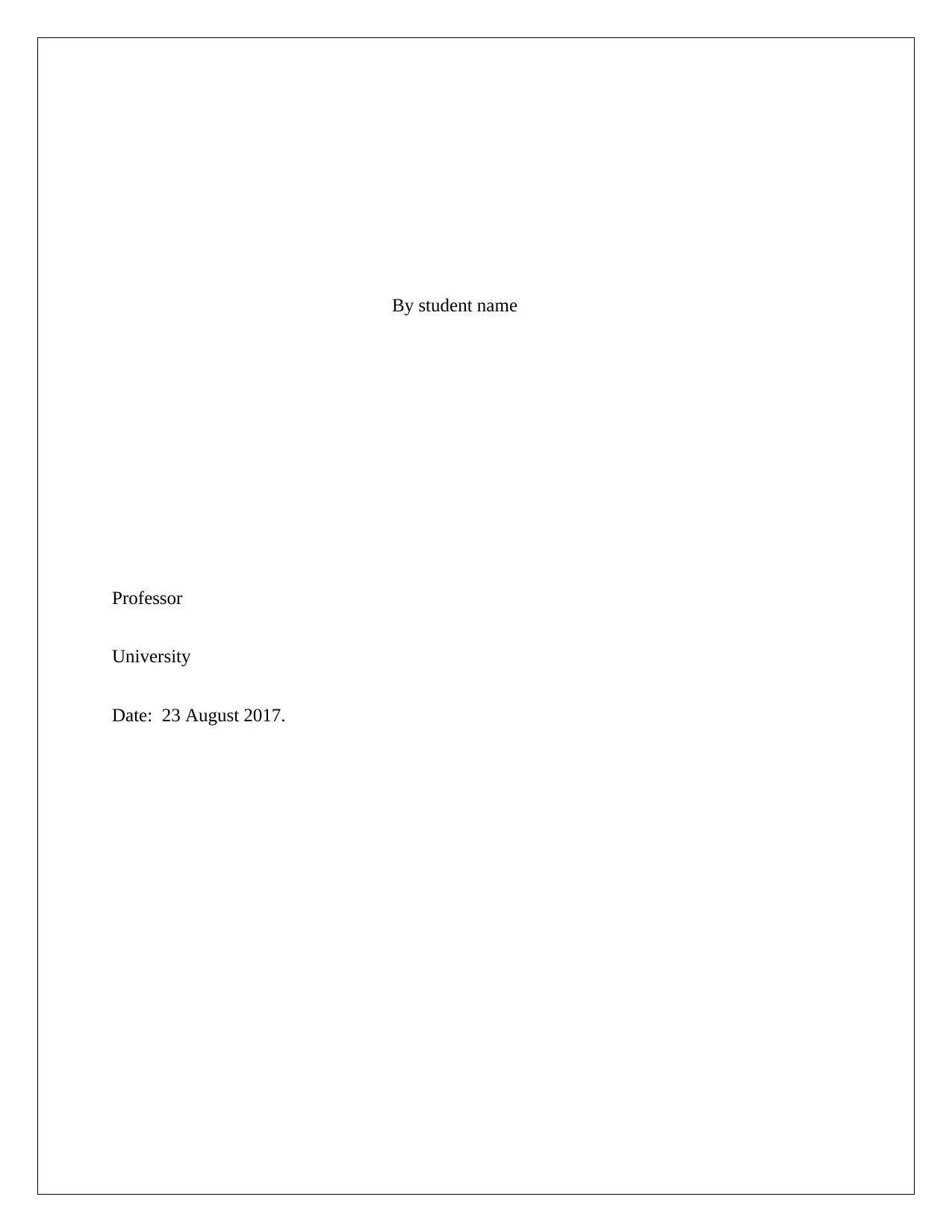
By student name
Professor
University
Date: 23 August 2017.
Professor
University
Date: 23 August 2017.
Paraphrase This Document
Need a fresh take? Get an instant paraphrase of this document with our AI Paraphraser
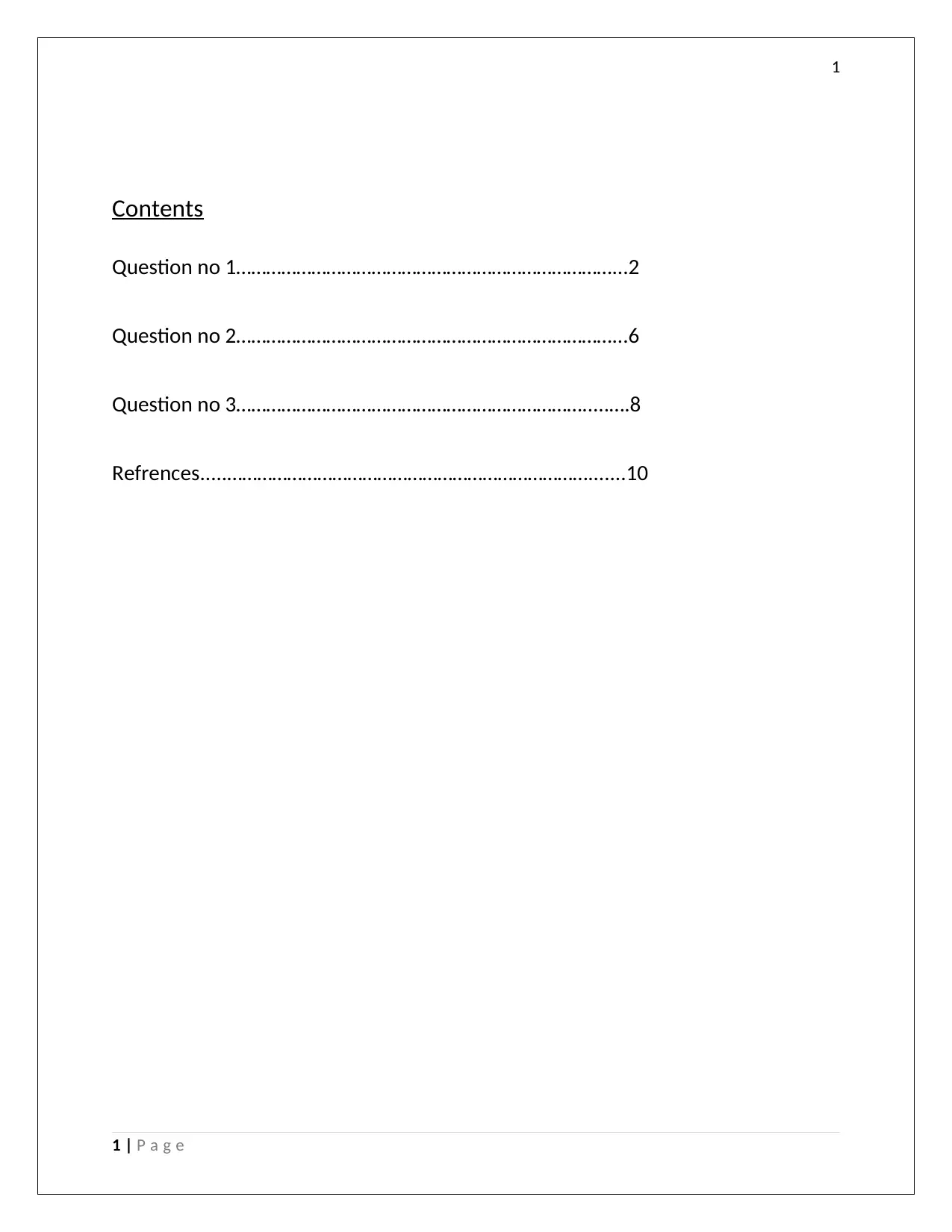
1
Contents
Question no 1…………………………………………………………………...2
Question no 2…………………………………………………………………...6
Question no 3…………………………………………………………….....….8
Refrences.....……………………………………………………………….......10
1 | P a g e
Contents
Question no 1…………………………………………………………………...2
Question no 2…………………………………………………………………...6
Question no 3…………………………………………………………….....….8
Refrences.....……………………………………………………………….......10
1 | P a g e
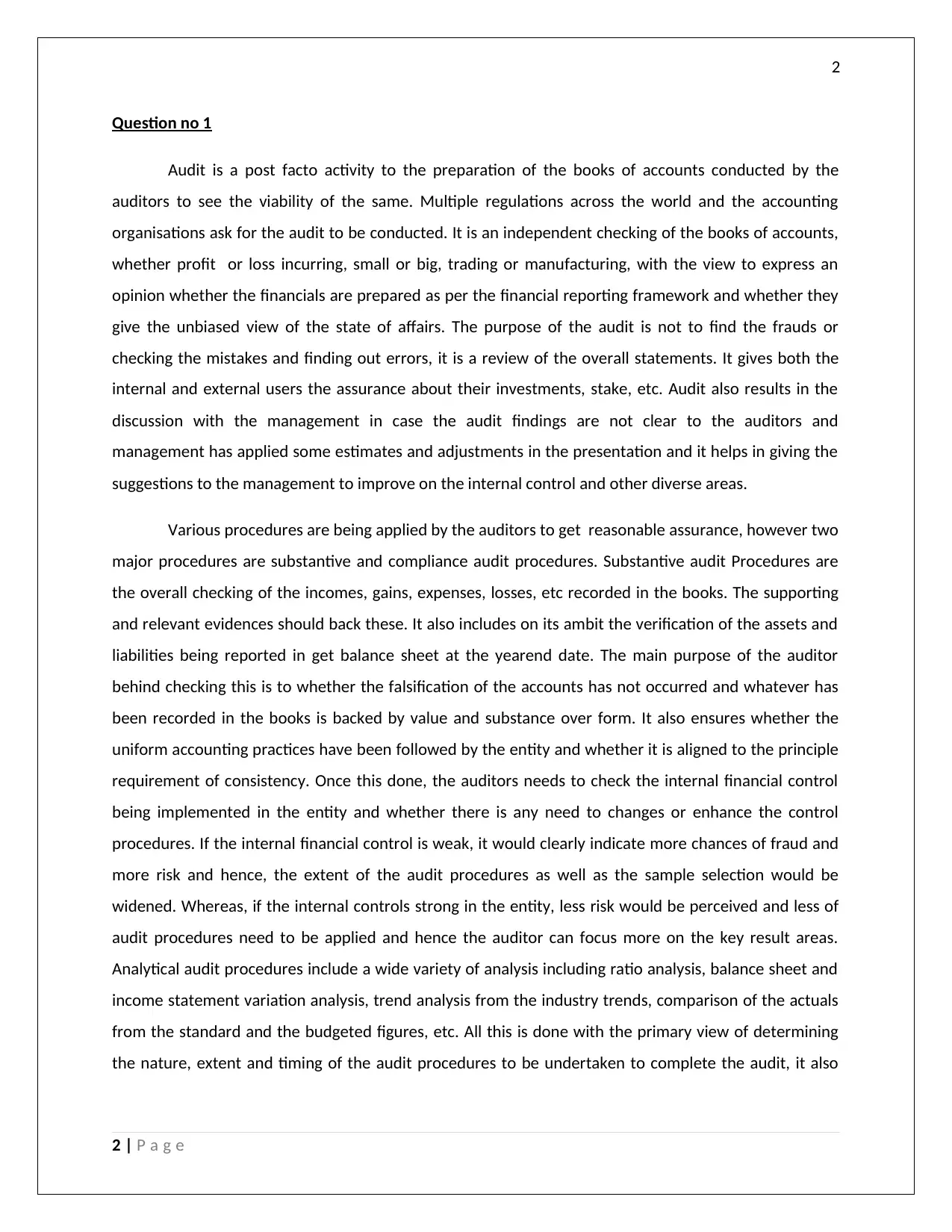
2
Question no 1
Audit is a post facto activity to the preparation of the books of accounts conducted by the
auditors to see the viability of the same. Multiple regulations across the world and the accounting
organisations ask for the audit to be conducted. It is an independent checking of the books of accounts,
whether profit or loss incurring, small or big, trading or manufacturing, with the view to express an
opinion whether the financials are prepared as per the financial reporting framework and whether they
give the unbiased view of the state of affairs. The purpose of the audit is not to find the frauds or
checking the mistakes and finding out errors, it is a review of the overall statements. It gives both the
internal and external users the assurance about their investments, stake, etc. Audit also results in the
discussion with the management in case the audit findings are not clear to the auditors and
management has applied some estimates and adjustments in the presentation and it helps in giving the
suggestions to the management to improve on the internal control and other diverse areas.
Various procedures are being applied by the auditors to get reasonable assurance, however two
major procedures are substantive and compliance audit procedures. Substantive audit Procedures are
the overall checking of the incomes, gains, expenses, losses, etc recorded in the books. The supporting
and relevant evidences should back these. It also includes on its ambit the verification of the assets and
liabilities being reported in get balance sheet at the yearend date. The main purpose of the auditor
behind checking this is to whether the falsification of the accounts has not occurred and whatever has
been recorded in the books is backed by value and substance over form. It also ensures whether the
uniform accounting practices have been followed by the entity and whether it is aligned to the principle
requirement of consistency. Once this done, the auditors needs to check the internal financial control
being implemented in the entity and whether there is any need to changes or enhance the control
procedures. If the internal financial control is weak, it would clearly indicate more chances of fraud and
more risk and hence, the extent of the audit procedures as well as the sample selection would be
widened. Whereas, if the internal controls strong in the entity, less risk would be perceived and less of
audit procedures need to be applied and hence the auditor can focus more on the key result areas.
Analytical audit procedures include a wide variety of analysis including ratio analysis, balance sheet and
income statement variation analysis, trend analysis from the industry trends, comparison of the actuals
from the standard and the budgeted figures, etc. All this is done with the primary view of determining
the nature, extent and timing of the audit procedures to be undertaken to complete the audit, it also
2 | P a g e
Question no 1
Audit is a post facto activity to the preparation of the books of accounts conducted by the
auditors to see the viability of the same. Multiple regulations across the world and the accounting
organisations ask for the audit to be conducted. It is an independent checking of the books of accounts,
whether profit or loss incurring, small or big, trading or manufacturing, with the view to express an
opinion whether the financials are prepared as per the financial reporting framework and whether they
give the unbiased view of the state of affairs. The purpose of the audit is not to find the frauds or
checking the mistakes and finding out errors, it is a review of the overall statements. It gives both the
internal and external users the assurance about their investments, stake, etc. Audit also results in the
discussion with the management in case the audit findings are not clear to the auditors and
management has applied some estimates and adjustments in the presentation and it helps in giving the
suggestions to the management to improve on the internal control and other diverse areas.
Various procedures are being applied by the auditors to get reasonable assurance, however two
major procedures are substantive and compliance audit procedures. Substantive audit Procedures are
the overall checking of the incomes, gains, expenses, losses, etc recorded in the books. The supporting
and relevant evidences should back these. It also includes on its ambit the verification of the assets and
liabilities being reported in get balance sheet at the yearend date. The main purpose of the auditor
behind checking this is to whether the falsification of the accounts has not occurred and whatever has
been recorded in the books is backed by value and substance over form. It also ensures whether the
uniform accounting practices have been followed by the entity and whether it is aligned to the principle
requirement of consistency. Once this done, the auditors needs to check the internal financial control
being implemented in the entity and whether there is any need to changes or enhance the control
procedures. If the internal financial control is weak, it would clearly indicate more chances of fraud and
more risk and hence, the extent of the audit procedures as well as the sample selection would be
widened. Whereas, if the internal controls strong in the entity, less risk would be perceived and less of
audit procedures need to be applied and hence the auditor can focus more on the key result areas.
Analytical audit procedures include a wide variety of analysis including ratio analysis, balance sheet and
income statement variation analysis, trend analysis from the industry trends, comparison of the actuals
from the standard and the budgeted figures, etc. All this is done with the primary view of determining
the nature, extent and timing of the audit procedures to be undertaken to complete the audit, it also
2 | P a g e
⊘ This is a preview!⊘
Do you want full access?
Subscribe today to unlock all pages.

Trusted by 1+ million students worldwide
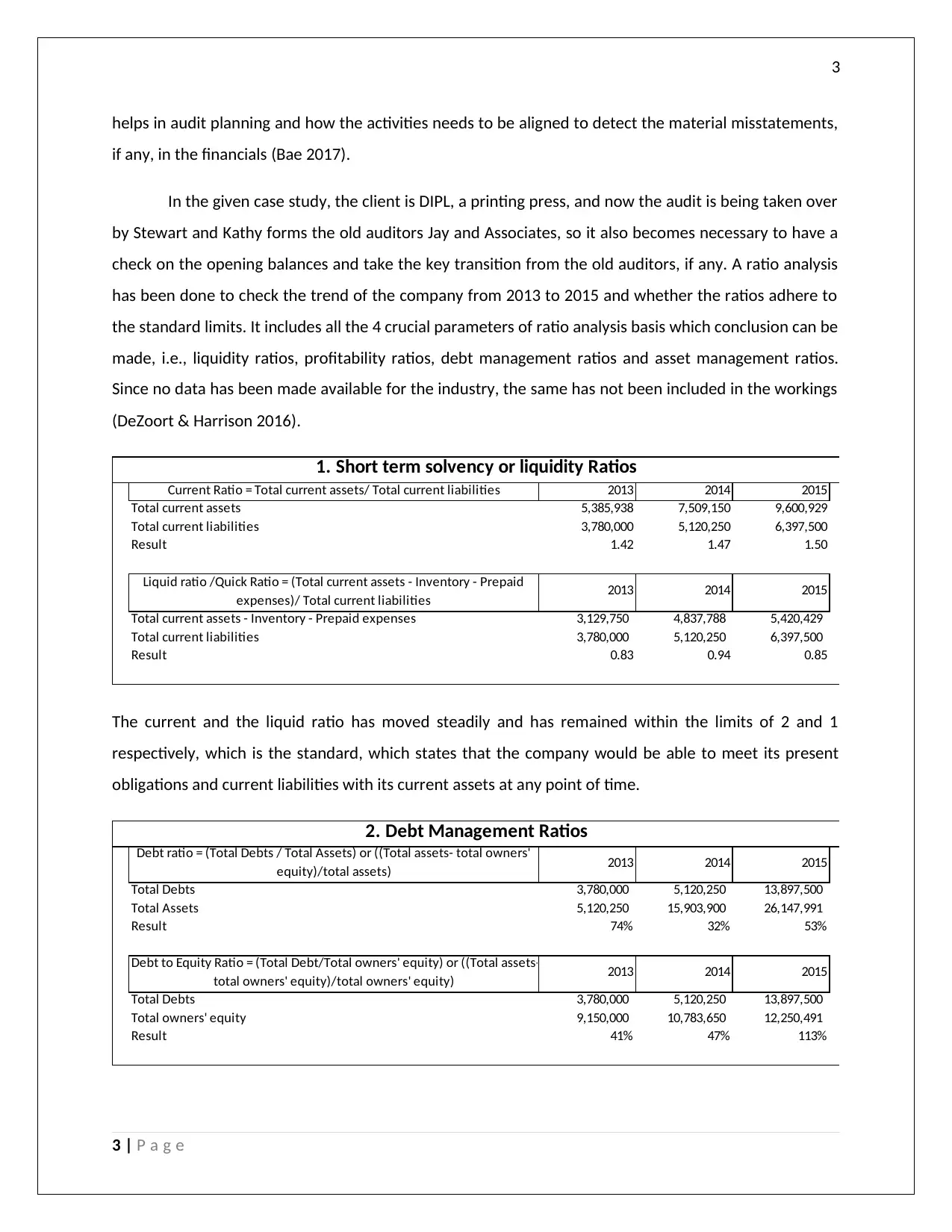
3
helps in audit planning and how the activities needs to be aligned to detect the material misstatements,
if any, in the financials (Bae 2017).
In the given case study, the client is DIPL, a printing press, and now the audit is being taken over
by Stewart and Kathy forms the old auditors Jay and Associates, so it also becomes necessary to have a
check on the opening balances and take the key transition from the old auditors, if any. A ratio analysis
has been done to check the trend of the company from 2013 to 2015 and whether the ratios adhere to
the standard limits. It includes all the 4 crucial parameters of ratio analysis basis which conclusion can be
made, i.e., liquidity ratios, profitability ratios, debt management ratios and asset management ratios.
Since no data has been made available for the industry, the same has not been included in the workings
(DeZoort & Harrison 2016).
2013 2014 2015
Total current assets 5,385,938 7,509,150 9,600,929
Total current liabilities 3,780,000 5,120,250 6,397,500
Result 1.42 1.47 1.50
2013 2014 2015
Total current assets - Inventory - Prepaid expenses 3,129,750 4,837,788 5,420,429
Total current liabilities 3,780,000 5,120,250 6,397,500
Result 0.83 0.94 0.85
Current Ratio = Total current assets/ Total current liabilities
Liquid ratio /Quick Ratio = (Total current assets - Inventory - Prepaid
expenses)/ Total current liabilities
1. Short term solvency or liquidity Ratios
The current and the liquid ratio has moved steadily and has remained within the limits of 2 and 1
respectively, which is the standard, which states that the company would be able to meet its present
obligations and current liabilities with its current assets at any point of time.
2013 2014 2015
Total Debts 3,780,000 5,120,250 13,897,500
Total Assets 5,120,250 15,903,900 26,147,991
Result 74% 32% 53%
2013 2014 2015
Total Debts 3,780,000 5,120,250 13,897,500
Total owners' equity 9,150,000 10,783,650 12,250,491
Result 41% 47% 113%
Debt ratio = (Total Debts / Total Assets) or ((Total assets- total owners'
equity)/total assets)
Debt to Equity Ratio = (Total Debt/Total owners' equity) or ((Total assets-
total owners' equity)/total owners' equity)
2. Debt Management Ratios
3 | P a g e
helps in audit planning and how the activities needs to be aligned to detect the material misstatements,
if any, in the financials (Bae 2017).
In the given case study, the client is DIPL, a printing press, and now the audit is being taken over
by Stewart and Kathy forms the old auditors Jay and Associates, so it also becomes necessary to have a
check on the opening balances and take the key transition from the old auditors, if any. A ratio analysis
has been done to check the trend of the company from 2013 to 2015 and whether the ratios adhere to
the standard limits. It includes all the 4 crucial parameters of ratio analysis basis which conclusion can be
made, i.e., liquidity ratios, profitability ratios, debt management ratios and asset management ratios.
Since no data has been made available for the industry, the same has not been included in the workings
(DeZoort & Harrison 2016).
2013 2014 2015
Total current assets 5,385,938 7,509,150 9,600,929
Total current liabilities 3,780,000 5,120,250 6,397,500
Result 1.42 1.47 1.50
2013 2014 2015
Total current assets - Inventory - Prepaid expenses 3,129,750 4,837,788 5,420,429
Total current liabilities 3,780,000 5,120,250 6,397,500
Result 0.83 0.94 0.85
Current Ratio = Total current assets/ Total current liabilities
Liquid ratio /Quick Ratio = (Total current assets - Inventory - Prepaid
expenses)/ Total current liabilities
1. Short term solvency or liquidity Ratios
The current and the liquid ratio has moved steadily and has remained within the limits of 2 and 1
respectively, which is the standard, which states that the company would be able to meet its present
obligations and current liabilities with its current assets at any point of time.
2013 2014 2015
Total Debts 3,780,000 5,120,250 13,897,500
Total Assets 5,120,250 15,903,900 26,147,991
Result 74% 32% 53%
2013 2014 2015
Total Debts 3,780,000 5,120,250 13,897,500
Total owners' equity 9,150,000 10,783,650 12,250,491
Result 41% 47% 113%
Debt ratio = (Total Debts / Total Assets) or ((Total assets- total owners'
equity)/total assets)
Debt to Equity Ratio = (Total Debt/Total owners' equity) or ((Total assets-
total owners' equity)/total owners' equity)
2. Debt Management Ratios
3 | P a g e
Paraphrase This Document
Need a fresh take? Get an instant paraphrase of this document with our AI Paraphraser
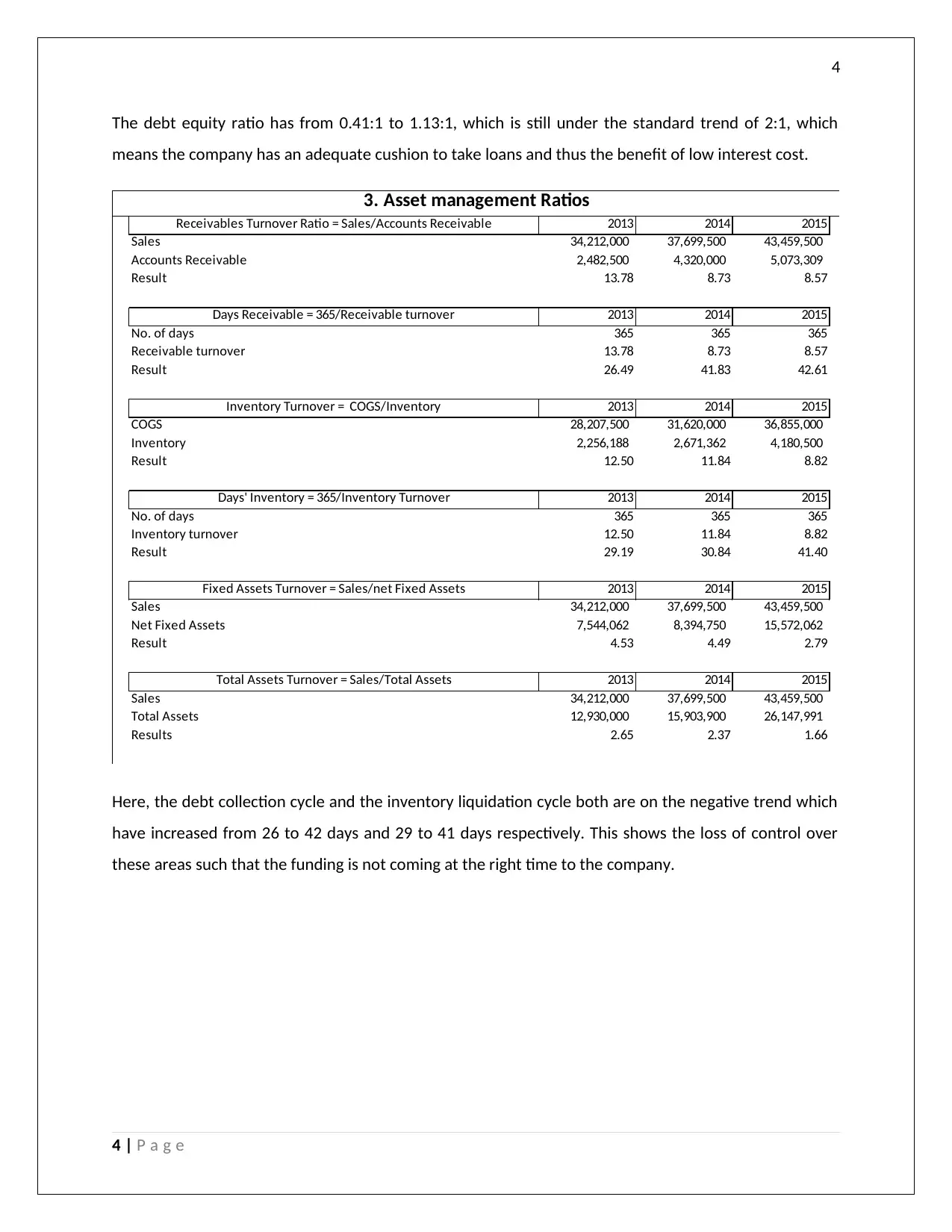
4
The debt equity ratio has from 0.41:1 to 1.13:1, which is still under the standard trend of 2:1, which
means the company has an adequate cushion to take loans and thus the benefit of low interest cost.
2013 2014 2015
Sales 34,212,000 37,699,500 43,459,500
Accounts Receivable 2,482,500 4,320,000 5,073,309
Result 13.78 8.73 8.57
2013 2014 2015
No. of days 365 365 365
Receivable turnover 13.78 8.73 8.57
Result 26.49 41.83 42.61
2013 2014 2015
COGS 28,207,500 31,620,000 36,855,000
Inventory 2,256,188 2,671,362 4,180,500
Result 12.50 11.84 8.82
2013 2014 2015
No. of days 365 365 365
Inventory turnover 12.50 11.84 8.82
Result 29.19 30.84 41.40
2013 2014 2015
Sales 34,212,000 37,699,500 43,459,500
Net Fixed Assets 7,544,062 8,394,750 15,572,062
Result 4.53 4.49 2.79
2013 2014 2015
Sales 34,212,000 37,699,500 43,459,500
Total Assets 12,930,000 15,903,900 26,147,991
Results 2.65 2.37 1.66
Inventory Turnover = COGS/Inventory
Days' Inventory = 365/Inventory Turnover
Fixed Assets Turnover = Sales/net Fixed Assets
Total Assets Turnover = Sales/Total Assets
Receivables Turnover Ratio = Sales/Accounts Receivable
Days Receivable = 365/Receivable turnover
3. Asset management Ratios
Here, the debt collection cycle and the inventory liquidation cycle both are on the negative trend which
have increased from 26 to 42 days and 29 to 41 days respectively. This shows the loss of control over
these areas such that the funding is not coming at the right time to the company.
4 | P a g e
The debt equity ratio has from 0.41:1 to 1.13:1, which is still under the standard trend of 2:1, which
means the company has an adequate cushion to take loans and thus the benefit of low interest cost.
2013 2014 2015
Sales 34,212,000 37,699,500 43,459,500
Accounts Receivable 2,482,500 4,320,000 5,073,309
Result 13.78 8.73 8.57
2013 2014 2015
No. of days 365 365 365
Receivable turnover 13.78 8.73 8.57
Result 26.49 41.83 42.61
2013 2014 2015
COGS 28,207,500 31,620,000 36,855,000
Inventory 2,256,188 2,671,362 4,180,500
Result 12.50 11.84 8.82
2013 2014 2015
No. of days 365 365 365
Inventory turnover 12.50 11.84 8.82
Result 29.19 30.84 41.40
2013 2014 2015
Sales 34,212,000 37,699,500 43,459,500
Net Fixed Assets 7,544,062 8,394,750 15,572,062
Result 4.53 4.49 2.79
2013 2014 2015
Sales 34,212,000 37,699,500 43,459,500
Total Assets 12,930,000 15,903,900 26,147,991
Results 2.65 2.37 1.66
Inventory Turnover = COGS/Inventory
Days' Inventory = 365/Inventory Turnover
Fixed Assets Turnover = Sales/net Fixed Assets
Total Assets Turnover = Sales/Total Assets
Receivables Turnover Ratio = Sales/Accounts Receivable
Days Receivable = 365/Receivable turnover
3. Asset management Ratios
Here, the debt collection cycle and the inventory liquidation cycle both are on the negative trend which
have increased from 26 to 42 days and 29 to 41 days respectively. This shows the loss of control over
these areas such that the funding is not coming at the right time to the company.
4 | P a g e
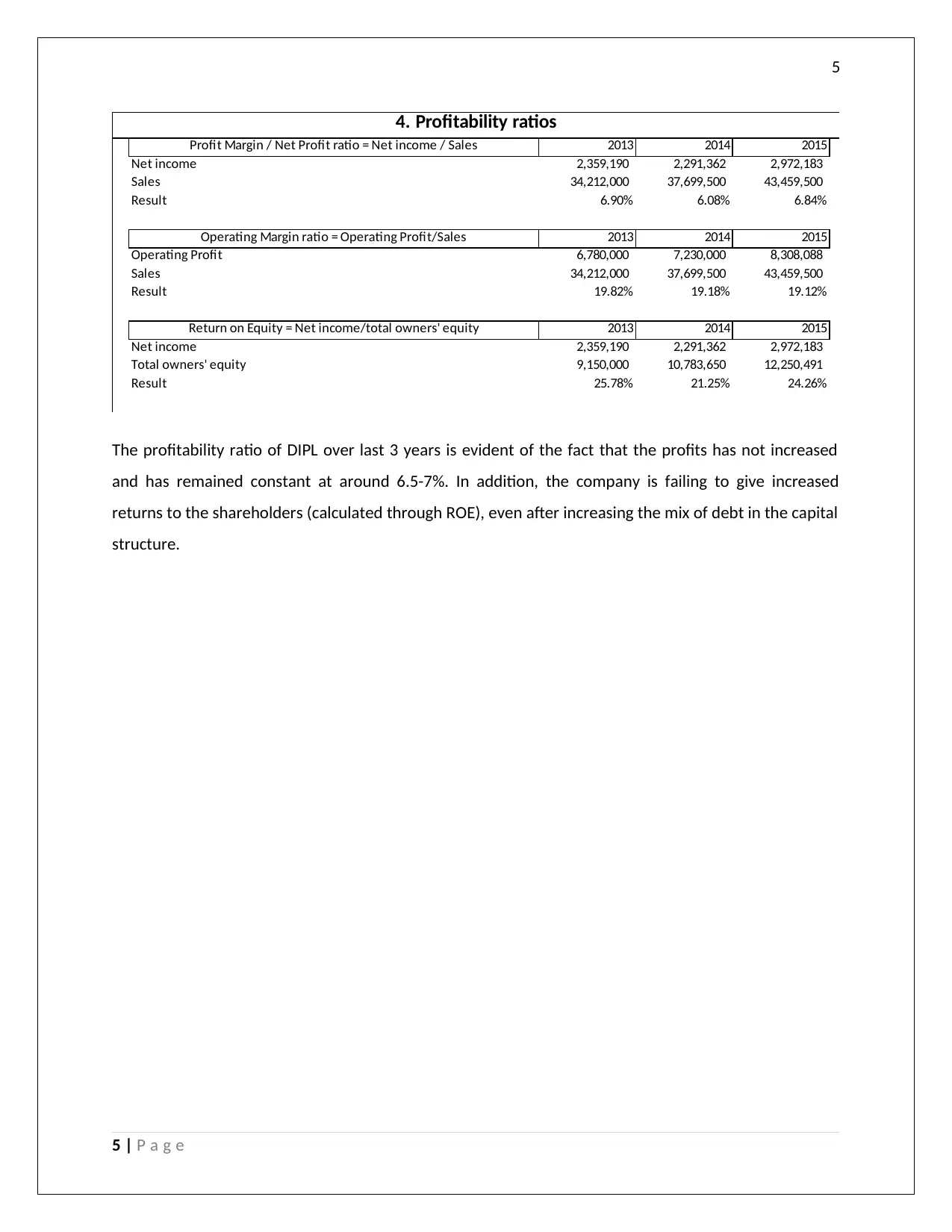
5
2013 2014 2015
Net income 2,359,190 2,291,362 2,972,183
Sales 34,212,000 37,699,500 43,459,500
Result 6.90% 6.08% 6.84%
2013 2014 2015
Operating Profit 6,780,000 7,230,000 8,308,088
Sales 34,212,000 37,699,500 43,459,500
Result 19.82% 19.18% 19.12%
2013 2014 2015
Net income 2,359,190 2,291,362 2,972,183
Total owners' equity 9,150,000 10,783,650 12,250,491
Result 25.78% 21.25% 24.26%
Profit Margin / Net Profit ratio = Net income / Sales
Operating Margin ratio = Operating Profit/Sales
Return on Equity = Net income/total owners' equity
4. Profitability ratios
The profitability ratio of DIPL over last 3 years is evident of the fact that the profits has not increased
and has remained constant at around 6.5-7%. In addition, the company is failing to give increased
returns to the shareholders (calculated through ROE), even after increasing the mix of debt in the capital
structure.
5 | P a g e
2013 2014 2015
Net income 2,359,190 2,291,362 2,972,183
Sales 34,212,000 37,699,500 43,459,500
Result 6.90% 6.08% 6.84%
2013 2014 2015
Operating Profit 6,780,000 7,230,000 8,308,088
Sales 34,212,000 37,699,500 43,459,500
Result 19.82% 19.18% 19.12%
2013 2014 2015
Net income 2,359,190 2,291,362 2,972,183
Total owners' equity 9,150,000 10,783,650 12,250,491
Result 25.78% 21.25% 24.26%
Profit Margin / Net Profit ratio = Net income / Sales
Operating Margin ratio = Operating Profit/Sales
Return on Equity = Net income/total owners' equity
4. Profitability ratios
The profitability ratio of DIPL over last 3 years is evident of the fact that the profits has not increased
and has remained constant at around 6.5-7%. In addition, the company is failing to give increased
returns to the shareholders (calculated through ROE), even after increasing the mix of debt in the capital
structure.
5 | P a g e
⊘ This is a preview!⊘
Do you want full access?
Subscribe today to unlock all pages.

Trusted by 1+ million students worldwide
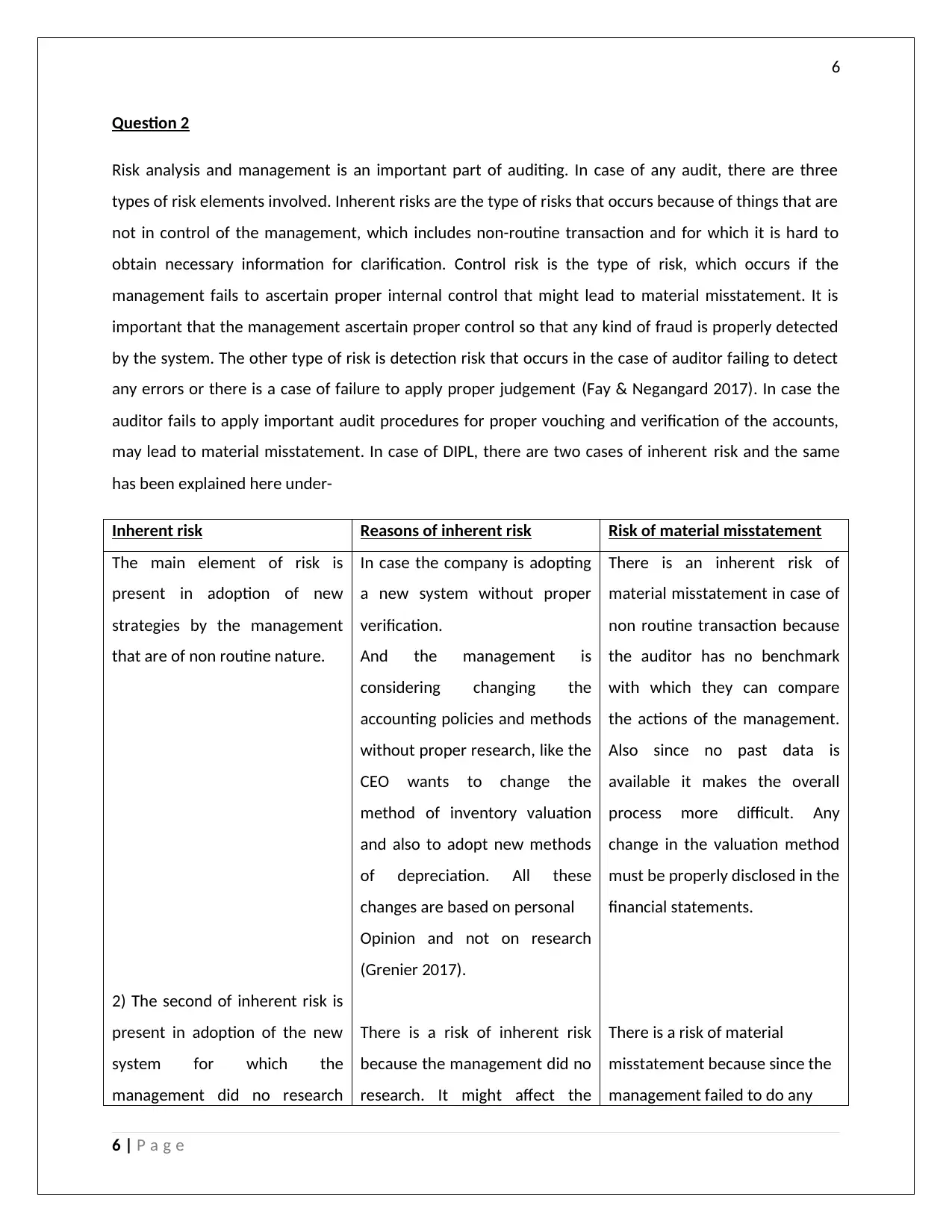
6
Question 2
Risk analysis and management is an important part of auditing. In case of any audit, there are three
types of risk elements involved. Inherent risks are the type of risks that occurs because of things that are
not in control of the management, which includes non-routine transaction and for which it is hard to
obtain necessary information for clarification. Control risk is the type of risk, which occurs if the
management fails to ascertain proper internal control that might lead to material misstatement. It is
important that the management ascertain proper control so that any kind of fraud is properly detected
by the system. The other type of risk is detection risk that occurs in the case of auditor failing to detect
any errors or there is a case of failure to apply proper judgement (Fay & Negangard 2017). In case the
auditor fails to apply important audit procedures for proper vouching and verification of the accounts,
may lead to material misstatement. In case of DIPL, there are two cases of inherent risk and the same
has been explained here under-
Inherent risk Reasons of inherent risk Risk of material misstatement
The main element of risk is
present in adoption of new
strategies by the management
that are of non routine nature.
2) The second of inherent risk is
present in adoption of the new
system for which the
management did no research
In case the company is adopting
a new system without proper
verification.
And the management is
considering changing the
accounting policies and methods
without proper research, like the
CEO wants to change the
method of inventory valuation
and also to adopt new methods
of depreciation. All these
changes are based on personal
Opinion and not on research
(Grenier 2017).
There is a risk of inherent risk
because the management did no
research. It might affect the
There is an inherent risk of
material misstatement in case of
non routine transaction because
the auditor has no benchmark
with which they can compare
the actions of the management.
Also since no past data is
available it makes the overall
process more difficult. Any
change in the valuation method
must be properly disclosed in the
financial statements.
There is a risk of material
misstatement because since the
management failed to do any
6 | P a g e
Question 2
Risk analysis and management is an important part of auditing. In case of any audit, there are three
types of risk elements involved. Inherent risks are the type of risks that occurs because of things that are
not in control of the management, which includes non-routine transaction and for which it is hard to
obtain necessary information for clarification. Control risk is the type of risk, which occurs if the
management fails to ascertain proper internal control that might lead to material misstatement. It is
important that the management ascertain proper control so that any kind of fraud is properly detected
by the system. The other type of risk is detection risk that occurs in the case of auditor failing to detect
any errors or there is a case of failure to apply proper judgement (Fay & Negangard 2017). In case the
auditor fails to apply important audit procedures for proper vouching and verification of the accounts,
may lead to material misstatement. In case of DIPL, there are two cases of inherent risk and the same
has been explained here under-
Inherent risk Reasons of inherent risk Risk of material misstatement
The main element of risk is
present in adoption of new
strategies by the management
that are of non routine nature.
2) The second of inherent risk is
present in adoption of the new
system for which the
management did no research
In case the company is adopting
a new system without proper
verification.
And the management is
considering changing the
accounting policies and methods
without proper research, like the
CEO wants to change the
method of inventory valuation
and also to adopt new methods
of depreciation. All these
changes are based on personal
Opinion and not on research
(Grenier 2017).
There is a risk of inherent risk
because the management did no
research. It might affect the
There is an inherent risk of
material misstatement in case of
non routine transaction because
the auditor has no benchmark
with which they can compare
the actions of the management.
Also since no past data is
available it makes the overall
process more difficult. Any
change in the valuation method
must be properly disclosed in the
financial statements.
There is a risk of material
misstatement because since the
management failed to do any
6 | P a g e
Paraphrase This Document
Need a fresh take? Get an instant paraphrase of this document with our AI Paraphraser
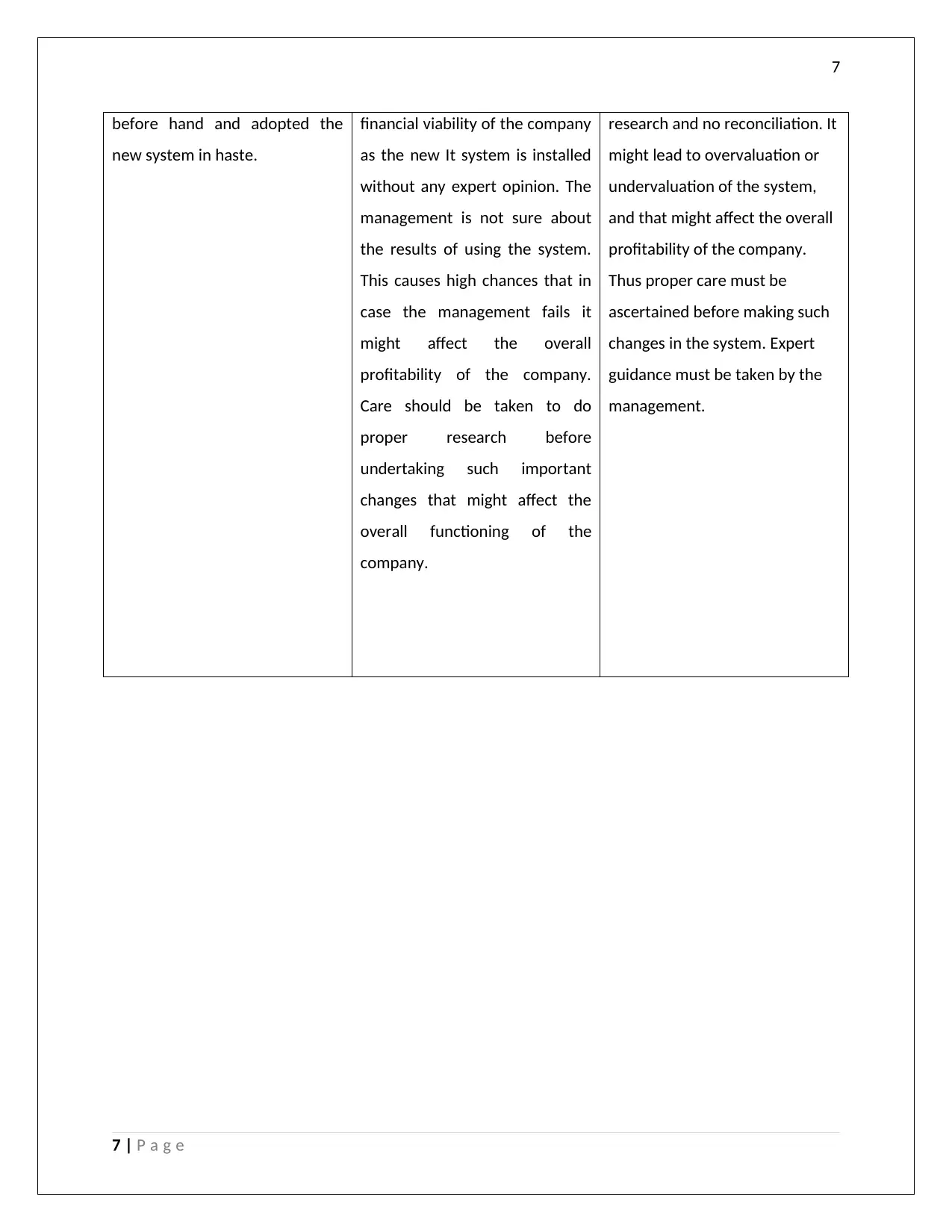
7
before hand and adopted the
new system in haste.
financial viability of the company
as the new It system is installed
without any expert opinion. The
management is not sure about
the results of using the system.
This causes high chances that in
case the management fails it
might affect the overall
profitability of the company.
Care should be taken to do
proper research before
undertaking such important
changes that might affect the
overall functioning of the
company.
research and no reconciliation. It
might lead to overvaluation or
undervaluation of the system,
and that might affect the overall
profitability of the company.
Thus proper care must be
ascertained before making such
changes in the system. Expert
guidance must be taken by the
management.
7 | P a g e
before hand and adopted the
new system in haste.
financial viability of the company
as the new It system is installed
without any expert opinion. The
management is not sure about
the results of using the system.
This causes high chances that in
case the management fails it
might affect the overall
profitability of the company.
Care should be taken to do
proper research before
undertaking such important
changes that might affect the
overall functioning of the
company.
research and no reconciliation. It
might lead to overvaluation or
undervaluation of the system,
and that might affect the overall
profitability of the company.
Thus proper care must be
ascertained before making such
changes in the system. Expert
guidance must be taken by the
management.
7 | P a g e
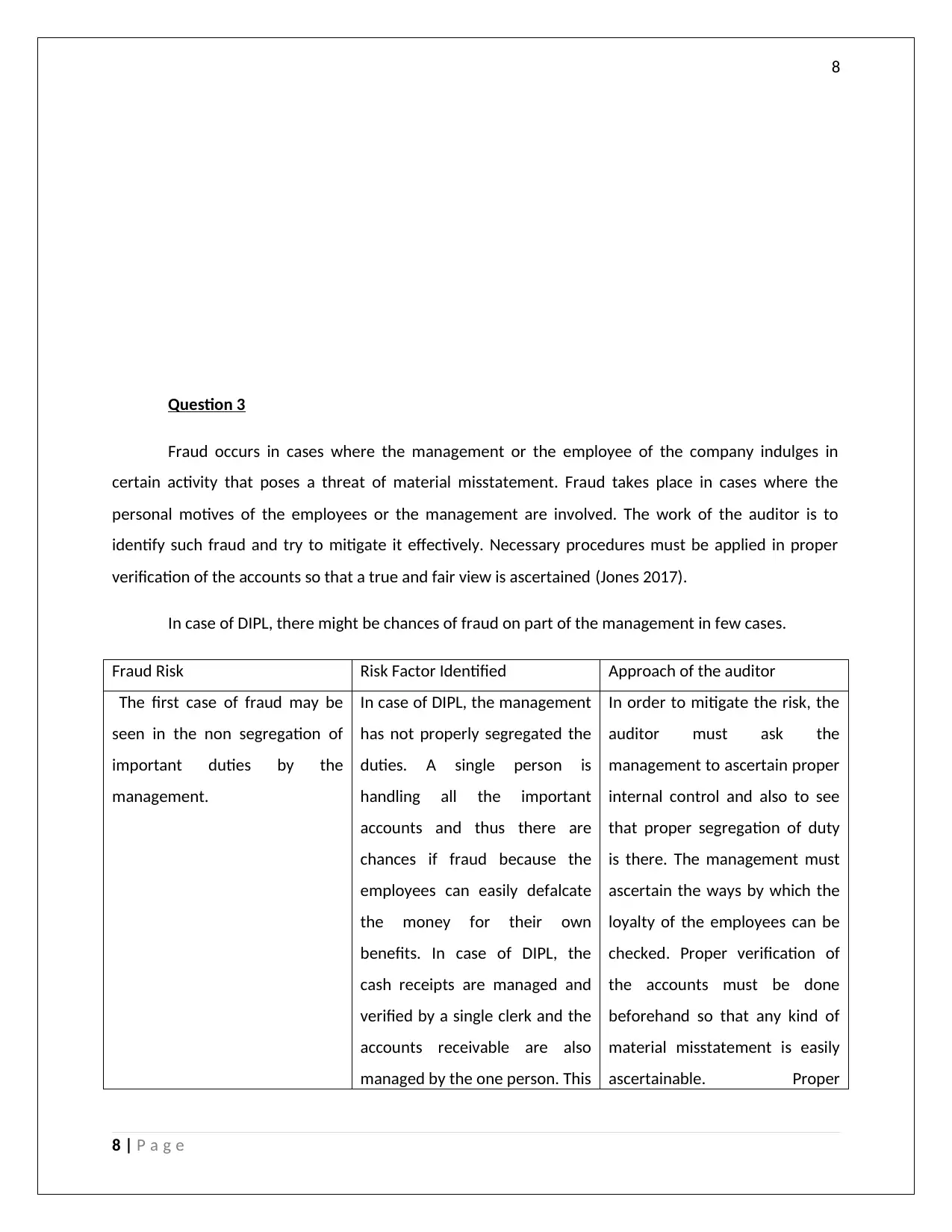
8
Question 3
Fraud occurs in cases where the management or the employee of the company indulges in
certain activity that poses a threat of material misstatement. Fraud takes place in cases where the
personal motives of the employees or the management are involved. The work of the auditor is to
identify such fraud and try to mitigate it effectively. Necessary procedures must be applied in proper
verification of the accounts so that a true and fair view is ascertained (Jones 2017).
In case of DIPL, there might be chances of fraud on part of the management in few cases.
Fraud Risk Risk Factor Identified Approach of the auditor
The first case of fraud may be
seen in the non segregation of
important duties by the
management.
In case of DIPL, the management
has not properly segregated the
duties. A single person is
handling all the important
accounts and thus there are
chances if fraud because the
employees can easily defalcate
the money for their own
benefits. In case of DIPL, the
cash receipts are managed and
verified by a single clerk and the
accounts receivable are also
managed by the one person. This
In order to mitigate the risk, the
auditor must ask the
management to ascertain proper
internal control and also to see
that proper segregation of duty
is there. The management must
ascertain the ways by which the
loyalty of the employees can be
checked. Proper verification of
the accounts must be done
beforehand so that any kind of
material misstatement is easily
ascertainable. Proper
8 | P a g e
Question 3
Fraud occurs in cases where the management or the employee of the company indulges in
certain activity that poses a threat of material misstatement. Fraud takes place in cases where the
personal motives of the employees or the management are involved. The work of the auditor is to
identify such fraud and try to mitigate it effectively. Necessary procedures must be applied in proper
verification of the accounts so that a true and fair view is ascertained (Jones 2017).
In case of DIPL, there might be chances of fraud on part of the management in few cases.
Fraud Risk Risk Factor Identified Approach of the auditor
The first case of fraud may be
seen in the non segregation of
important duties by the
management.
In case of DIPL, the management
has not properly segregated the
duties. A single person is
handling all the important
accounts and thus there are
chances if fraud because the
employees can easily defalcate
the money for their own
benefits. In case of DIPL, the
cash receipts are managed and
verified by a single clerk and the
accounts receivable are also
managed by the one person. This
In order to mitigate the risk, the
auditor must ask the
management to ascertain proper
internal control and also to see
that proper segregation of duty
is there. The management must
ascertain the ways by which the
loyalty of the employees can be
checked. Proper verification of
the accounts must be done
beforehand so that any kind of
material misstatement is easily
ascertainable. Proper
8 | P a g e
⊘ This is a preview!⊘
Do you want full access?
Subscribe today to unlock all pages.

Trusted by 1+ million students worldwide
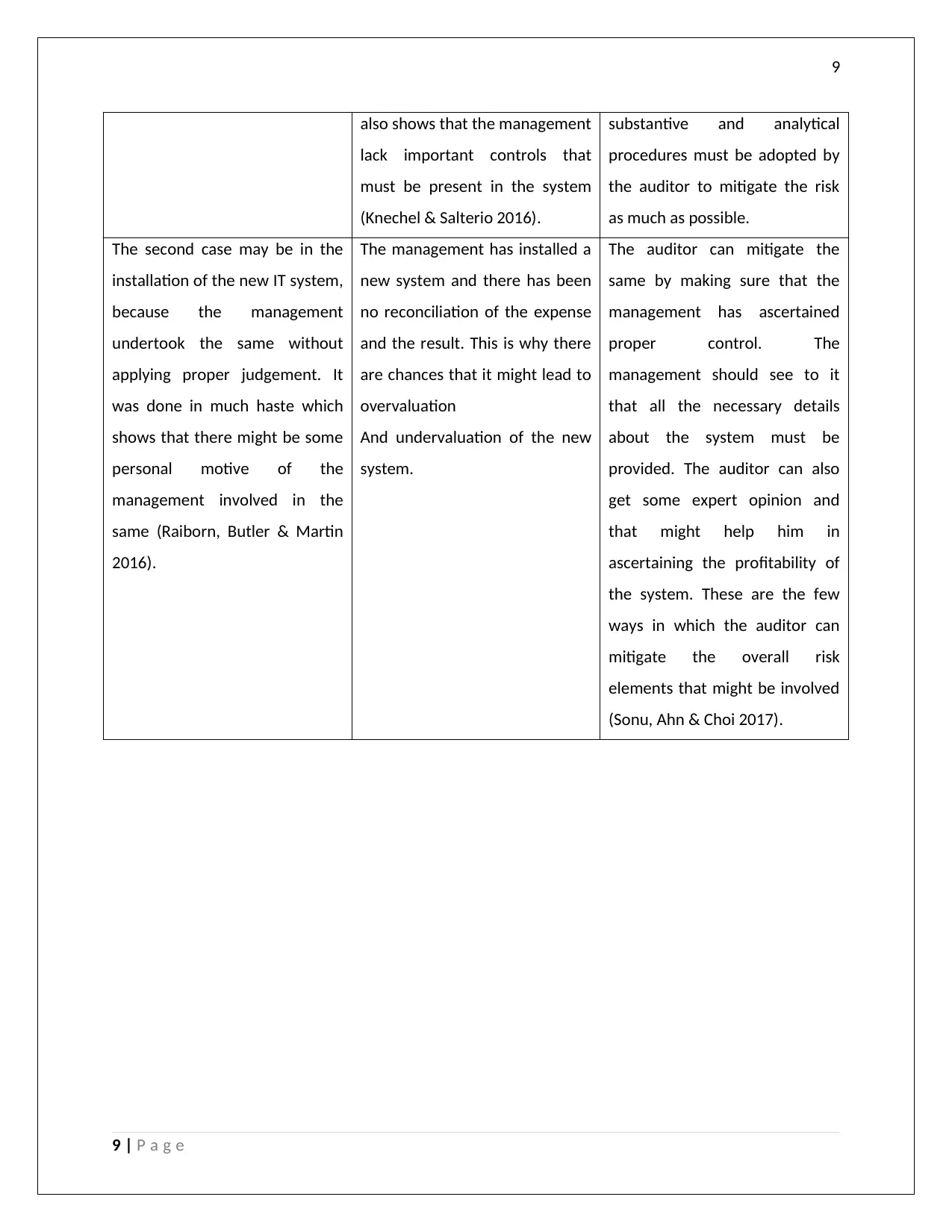
9
also shows that the management
lack important controls that
must be present in the system
(Knechel & Salterio 2016).
substantive and analytical
procedures must be adopted by
the auditor to mitigate the risk
as much as possible.
The second case may be in the
installation of the new IT system,
because the management
undertook the same without
applying proper judgement. It
was done in much haste which
shows that there might be some
personal motive of the
management involved in the
same (Raiborn, Butler & Martin
2016).
The management has installed a
new system and there has been
no reconciliation of the expense
and the result. This is why there
are chances that it might lead to
overvaluation
And undervaluation of the new
system.
The auditor can mitigate the
same by making sure that the
management has ascertained
proper control. The
management should see to it
that all the necessary details
about the system must be
provided. The auditor can also
get some expert opinion and
that might help him in
ascertaining the profitability of
the system. These are the few
ways in which the auditor can
mitigate the overall risk
elements that might be involved
(Sonu, Ahn & Choi 2017).
9 | P a g e
also shows that the management
lack important controls that
must be present in the system
(Knechel & Salterio 2016).
substantive and analytical
procedures must be adopted by
the auditor to mitigate the risk
as much as possible.
The second case may be in the
installation of the new IT system,
because the management
undertook the same without
applying proper judgement. It
was done in much haste which
shows that there might be some
personal motive of the
management involved in the
same (Raiborn, Butler & Martin
2016).
The management has installed a
new system and there has been
no reconciliation of the expense
and the result. This is why there
are chances that it might lead to
overvaluation
And undervaluation of the new
system.
The auditor can mitigate the
same by making sure that the
management has ascertained
proper control. The
management should see to it
that all the necessary details
about the system must be
provided. The auditor can also
get some expert opinion and
that might help him in
ascertaining the profitability of
the system. These are the few
ways in which the auditor can
mitigate the overall risk
elements that might be involved
(Sonu, Ahn & Choi 2017).
9 | P a g e
Paraphrase This Document
Need a fresh take? Get an instant paraphrase of this document with our AI Paraphraser
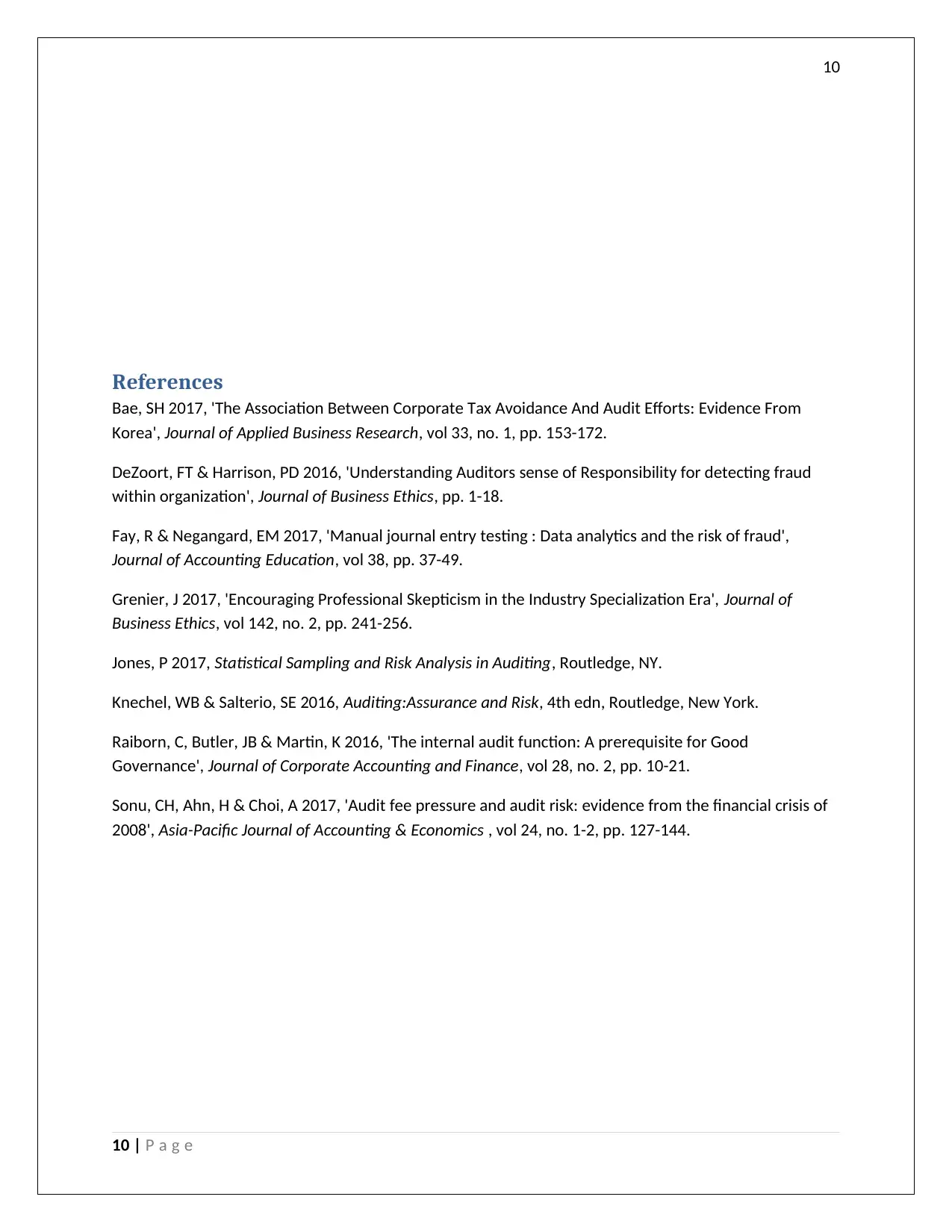
10
References
Bae, SH 2017, 'The Association Between Corporate Tax Avoidance And Audit Efforts: Evidence From
Korea', Journal of Applied Business Research, vol 33, no. 1, pp. 153-172.
DeZoort, FT & Harrison, PD 2016, 'Understanding Auditors sense of Responsibility for detecting fraud
within organization', Journal of Business Ethics, pp. 1-18.
Fay, R & Negangard, EM 2017, 'Manual journal entry testing : Data analytics and the risk of fraud',
Journal of Accounting Education, vol 38, pp. 37-49.
Grenier, J 2017, 'Encouraging Professional Skepticism in the Industry Specialization Era', Journal of
Business Ethics, vol 142, no. 2, pp. 241-256.
Jones, P 2017, Statistical Sampling and Risk Analysis in Auditing, Routledge, NY.
Knechel, WB & Salterio, SE 2016, Auditing:Assurance and Risk, 4th edn, Routledge, New York.
Raiborn, C, Butler, JB & Martin, K 2016, 'The internal audit function: A prerequisite for Good
Governance', Journal of Corporate Accounting and Finance, vol 28, no. 2, pp. 10-21.
Sonu, CH, Ahn, H & Choi, A 2017, 'Audit fee pressure and audit risk: evidence from the financial crisis of
2008', Asia-Pacific Journal of Accounting & Economics , vol 24, no. 1-2, pp. 127-144.
10 | P a g e
References
Bae, SH 2017, 'The Association Between Corporate Tax Avoidance And Audit Efforts: Evidence From
Korea', Journal of Applied Business Research, vol 33, no. 1, pp. 153-172.
DeZoort, FT & Harrison, PD 2016, 'Understanding Auditors sense of Responsibility for detecting fraud
within organization', Journal of Business Ethics, pp. 1-18.
Fay, R & Negangard, EM 2017, 'Manual journal entry testing : Data analytics and the risk of fraud',
Journal of Accounting Education, vol 38, pp. 37-49.
Grenier, J 2017, 'Encouraging Professional Skepticism in the Industry Specialization Era', Journal of
Business Ethics, vol 142, no. 2, pp. 241-256.
Jones, P 2017, Statistical Sampling and Risk Analysis in Auditing, Routledge, NY.
Knechel, WB & Salterio, SE 2016, Auditing:Assurance and Risk, 4th edn, Routledge, New York.
Raiborn, C, Butler, JB & Martin, K 2016, 'The internal audit function: A prerequisite for Good
Governance', Journal of Corporate Accounting and Finance, vol 28, no. 2, pp. 10-21.
Sonu, CH, Ahn, H & Choi, A 2017, 'Audit fee pressure and audit risk: evidence from the financial crisis of
2008', Asia-Pacific Journal of Accounting & Economics , vol 24, no. 1-2, pp. 127-144.
10 | P a g e
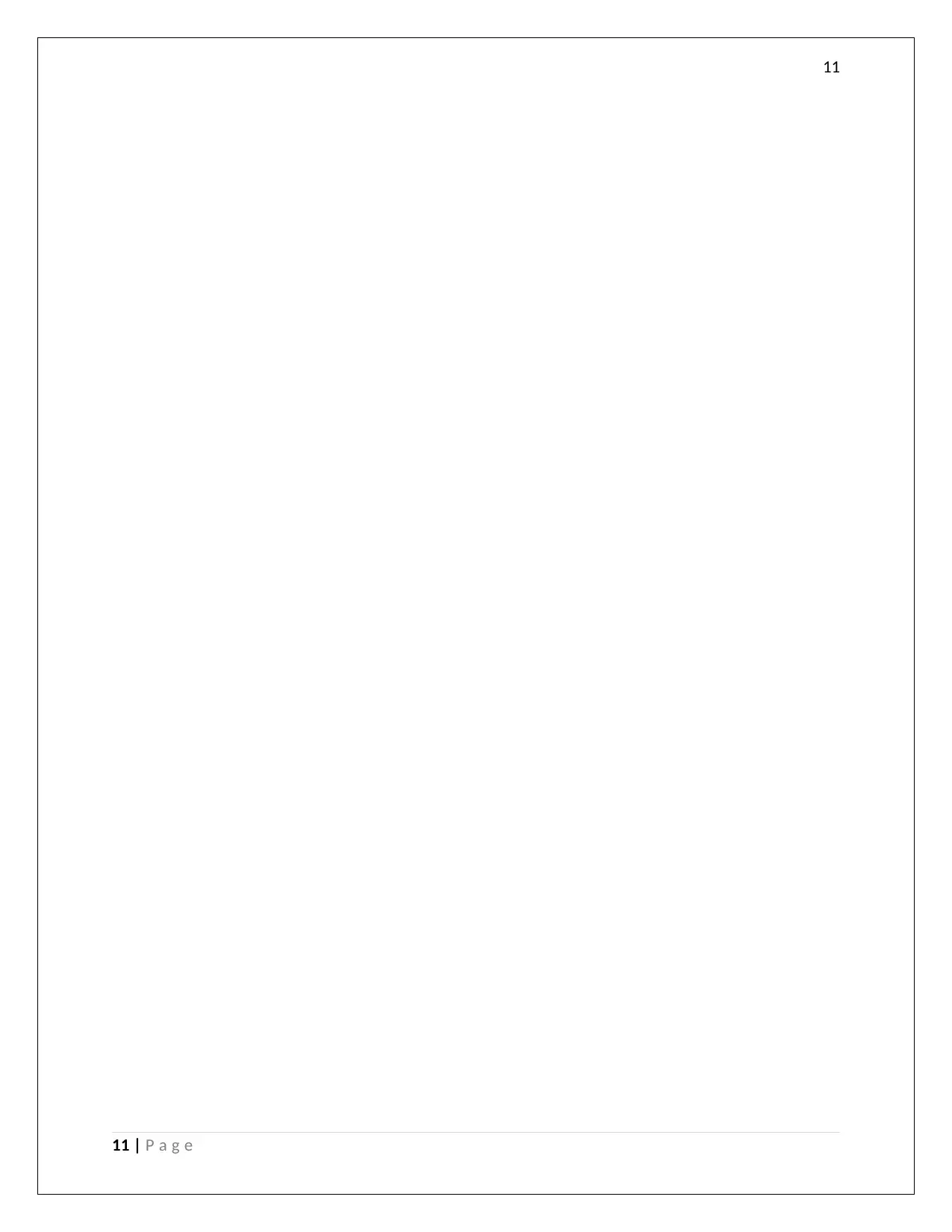
11
11 | P a g e
11 | P a g e
⊘ This is a preview!⊘
Do you want full access?
Subscribe today to unlock all pages.

Trusted by 1+ million students worldwide
1 out of 12
Related Documents
Your All-in-One AI-Powered Toolkit for Academic Success.
+13062052269
info@desklib.com
Available 24*7 on WhatsApp / Email
![[object Object]](/_next/static/media/star-bottom.7253800d.svg)
Unlock your academic potential
Copyright © 2020–2025 A2Z Services. All Rights Reserved. Developed and managed by ZUCOL.





